An additive three-color lenticular screen process from the 1930s and 1940s, most notably used on Jacques Tati’s color version of Jour de fête (1947).
Film Explorer

A unique sample of a color chart printed onto a 35mm double-coated (duplitized) film (c. 1947).
François Ede Collection, Paris, France.
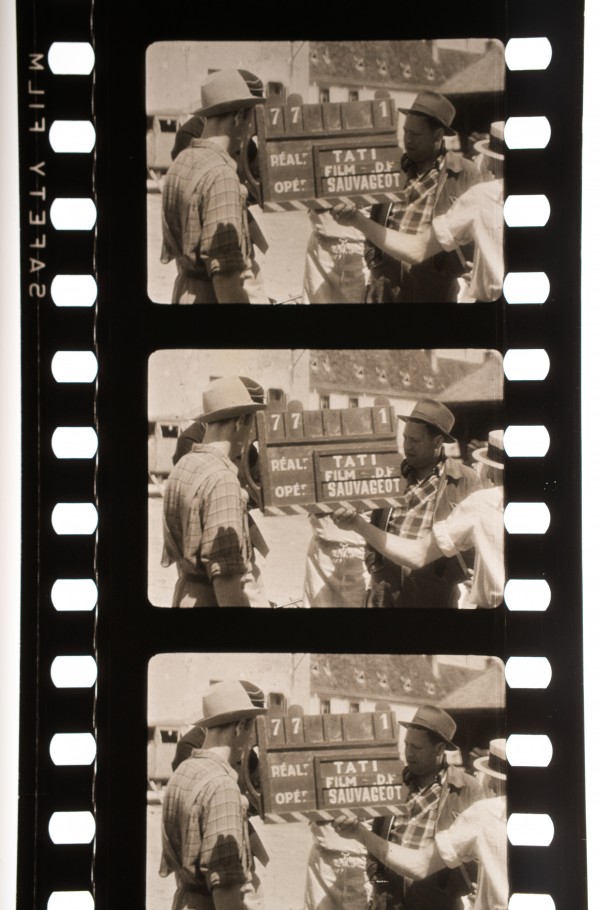
35mm B/W reversal camera film on embossed base from the production of the unreleased color version of Jacques Tati’s Jour de fête (1947). The color information recorded on this film could only be revealed in printing or direct projection through a three-band color filter.
François Ede Collection, Paris, France.
Identification
Nitrate: 1930s
Diacetate: 1947
History
The Thomsoncolor process was a continuation of the Keller-Dorian process of the 1920s.
In 1932, the French telecommunications company Thomson-Houston acquired the patents of astronomer Charles Nordmann, relating mainly to a color printing process. Nordmann was entrusted with the management of Thomson-Houston’s research laboratory, but was quickly replaced in favor of Jacques de Lassus-St Geniès, an engineer and a close relative of a Thomson administrator.
The Thomson-Houston company pursued Nordmann’s research but it proved unpromising. The low activity of this research laboratory ceased completely when the Second World War broke out in September 1939.
In 1947, Thomson-Houston signed an agreement with the producer Fred Orain, then president of the Commission Supérieure Technique (CST). He was launching the production of Jour de fête (1947), the first feature film by Jacques Tati.
The shooting began before the construction of a color film laboratory in Nogent-sur-Marne was completed. The Thomson process was to abandon the lenticular film print in favor of a complex process of making B/W color separations from the reversal lenticular camera film, then printing those onto either side of a double-coated film print. This ultimately proved impractical. The Thomson-Houston laboratory never managed to deliver a single foot of color print and Jour de fête was eventually distributed only in a B/W version, which was photographed simultaneously with the Thomsoncolor version.
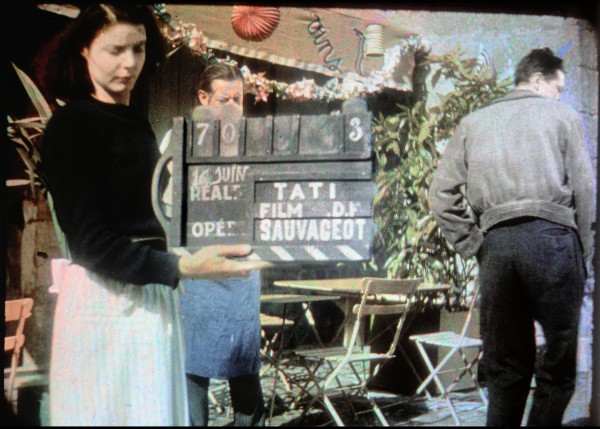
Shooting Jacques Tati’s Jour de fête (1947). The script-girl holds the slate for shot 70, take 3. This modern color image was made in the 1990s. The color is revealed from the B/W embossed camera film by optical reproduction through a three-band color filter onto Eastmancolor negative 5272.
François Ede Collection, Paris France.

Original reversal lenticular film strip shot by Thomson. La fête de l’eau at the Molitor swimming pool in Boulogne, July 1936. This modern color image has been reconstructed from the B/W embossed camera film by optical printing through a three-band RGB filter onto Eastmancolor intermediate 2254. Note the lenticules on the embossed film run vertically and remain clearly visible even after converting the image to color. The Thomsoncolor printing process was never perfected. The only concrete evidence of the research carried out is a short strip showing a color chart printed onto duplitized film stock. This modern color reproduction of the lenticular camera film can only give an impression of the qualities and weaknesses of the lenticular process.
Pierre Clavé collection, Cinémathèque française, Paris, France.
Selected Filmography
Technology
Shooting
The Thomsoncolor process used Eastman 1301 Embossed Film, a B/W camera reversal film with lenticules embossed into the base of the film. Based on surviving examples of Thomson-Houston tests from 1932 to 1939, it has been found that the embossed lenticules were used in both vertical and horizontal orientations. The embossing pitch was variable during this time: from 26 to 30 lines /mm. The embossing orientation used on Jour de fête in 1947 was vertical (625 lines across the width of the image).
The lens used for Jour de fête in 1947 was a 40mm Gauss Tachar. The RGB filter mounted inside the lens had a diameter of 10mm, which corresponds to a fixed aperture of f/4. The exposure was adjusted with a variable shutter.
Printing:
For the 1932–1939 period see Keller-Dorian and Chimicolor.
For the production of Jour de Fête in 1947 Thomson abandoned the printing on lenticular film and attempted converting the lenticular image onto a color double-coated multilayer film. But this new printing technique was not well documented.
The patent FR843946A, registered in 1939, was similar to a printing process protected by patent FR756344, issued in 1933 to Emmanuel-François Lessertisseux and exploited during the 1930s by the company Chimicolor.
Georges Bonnerot, who had worked with Henri Chrétien on the Keller Dorian process since 1924, followed the research work carried out by Thomson. In an unpublished document, he provides some details on the printing system used for the Thomsoncolor process:
“Thomsoncolor, wanting to avoid the problems of reproduction and projection, thus devised the following process whose ultimate objective was a film in color that could be screened everywhere.
1- Direct positive on reversal embossed film
2- RGB monochrome extractions from the embossed original film. [duplicate negative B/W color separations]
3- Printing on a double-coated film, on one side, the blue record, on the other the red one, with mordanting and separate tinting of each layer in the complementary colors (cyan and yellow).
4- Reapplying a third emulsion in darkroom, printing, mordanting and tinting (magenta).
The complexity of the process, the difficulty after mordanting to tint separately each layer, the insurmountable problem of keeping the three layers in registration, [...] for all of these reasons the printing process turn out to be unworkable.”

Left: 35mm B/W camera reversal film.
Right: same image after color has been restored. La fête de l'eau, Molitor swimming pool in Boulogne, July 1936.
François Ede Collection, Paris, France.
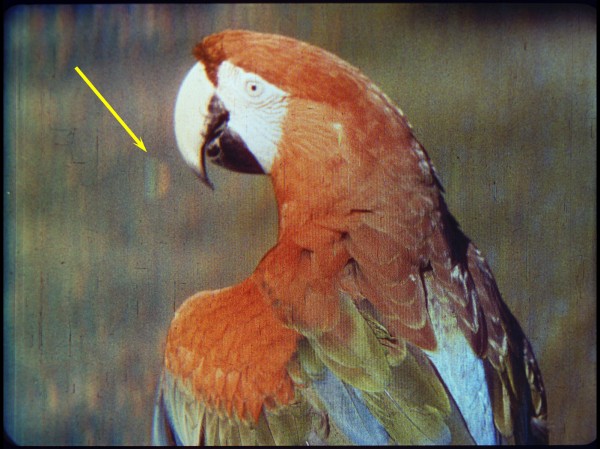
Film test (color reconstruction). Note the ghost image of the filter in the out-of-focus background (indicated with the yellow arrow).
François Ede Collection, Paris, France.
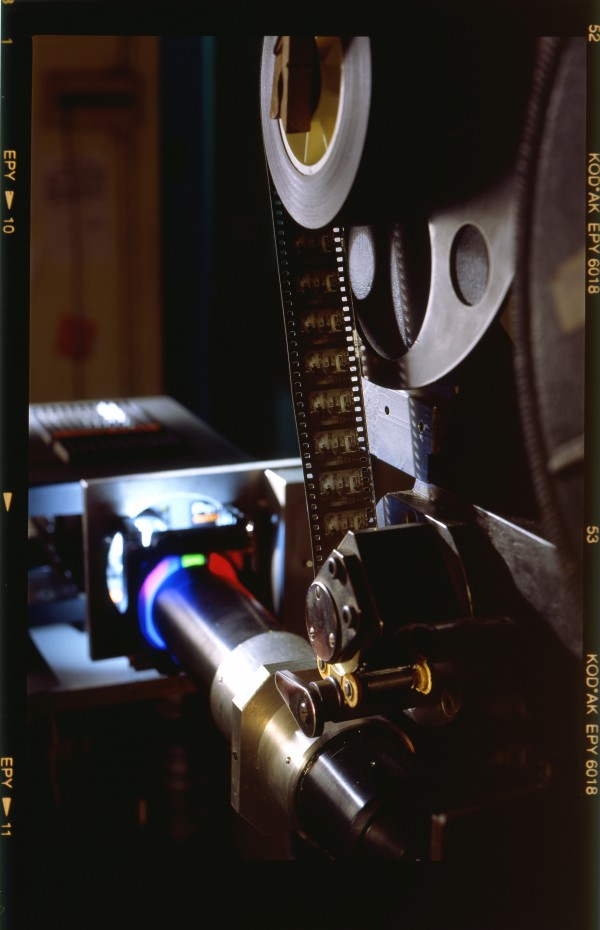
Optical printer, modified with a special lens with a three-band color filter, designed for the 1994 color restoration of Jacques Tati’s Jour de fête (1947).
François Ede Collection, Paris, France.
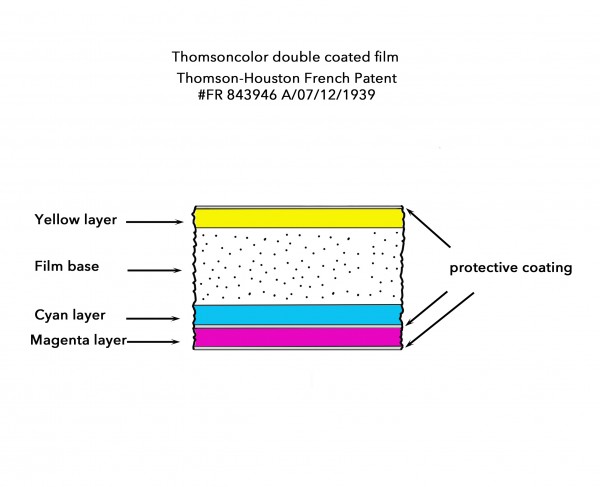
Diagram of the double-coated film used for making prints from the lenticular camera reversal film. (French patent #843 946)
François Ede Collection, Paris, France.
References
Cornwell-Clyne, Adrian (1951). Colour Cinematography. London: Chapman & Hall.
Ede, François (1995). Jour de Fête ou la couleur retrouvée. Paris: Cahiers du cinéma.
Ede, François (2013). “An Episode in the History of Film Colour: The Keller-Dorian Process and Lenticular Film”. 1895. Mille huit cent quatre-vingt-quinze, 71 (Winter). https://journals.openedition.org/1895/4787
Friedman, Joseph S. (1945). History of Color Photography. Boston, MA: The American Publishing Company.
Patents
Thomson Houston Compagnie Française. Procédé d'obtention d'images en couleurs sur films a plusieurs couches d'émulsion. French Patent FR843946A, filed March 21, 1938 and issued 12 July 1939. https://data.inpi.fr/brevets/FR843946
Compare
Related entries
Author
François Ede is a cinematographer and a documentary filmmaker. He has restored several films shot with the Keller-Dorian process, including Jour de fête in 1994 and recently carried out the reconstruction and restoration of Abel Gance's La Roue (1923) for the Jérôme Seydoux-Pathé Foundation.
Ede, François (2024). “Thomson Color”. In James Layton (ed.), Film Atlas. www.filmatlas.com. Brussels: International Federation of Film Archives / Rochester, NY: George Eastman Museum.


